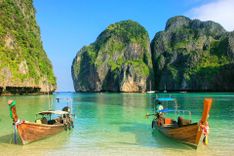Ko Chang activities
Tour agents on every beach or at your accommodation should be able to sell you tickets for most of the activities described below. There are spas at Ao Bai Lan and Ao Salak Kok; you can also snorkel and dive in the archipelago.
Elephant camps
Ko Chang or “Elephant Island” is named for its hilly profile rather than its indigenous pachyderms, but there are several elephant camps on the island that have brought in their own lumbering forest dwellers so that tourists can ride and help bathe them.
Ban Kwan Chang (Khlong Son) Elephant Camp
East of Khlong Son village (not to be confused with Baan Chang Thai in Khlong Phrao). Based in a quiet, forested area in the north of the island, this is the camp with the best reputation. It was set up by the man behind the Asian Elephant Foundation and is staffed by Suay mahouts and their elephants from Ban Ta Klang village in northeast Thailand, which has for centuries been a centre for working elephants. In the morning, visitors can either do a 40min elephant ride through adjacent plantations or extend the ride to an hour and bathe and feed the animals as well. Return transport from your accommodation is included. You could extend your trip to this part of the island by making the easy 300m walk to tiny Nang Yom falls, 500m beyond the camp, though Khlong Phlu falls in Khlong Phrao are more satisfying.
Kayaking
Kayak Chang is a well-organized, safety-conscious, British-run company offering half- and full-day local trips and expeditions around the archipelago of up to 7 days, as well as kayaking lessons and rental. Return transport from your accommodation is included.
Yoga
Baan Zen offers private, 90min yoga classes and short courses, as well as reiki courses.
Cooking classes
The amiable chef who runs the recommended KaTi restaurant teaches well-regarded cooking classes (Mon–Sat; B1200, including recipe book and transfers as far as White Sand Beach and Hat Kai Bae).
Diving and snorkelling in the Ko Chang archipelago
Because there’s just one main tide a day in the inner Gulf, the reefs of the Ko Chang archipelago are much less colourful and varied than Andaman coast dive sites, and they can get very crowded, but they’re rewarding enough to make a day-trip worthwhile. The main dive and snorkel sites are west of Ko Mak, in the national marine park around Ko Rang and its satellite islets. These range from beginners’ reefs with lots of hard corals and anemones at depths of 4–6m, frequented by plenty of reef fish – including a resident ten-thousand-strong shoal of yellow fusiliers – and the occasional moray eel, to the more challenging 25m dive at the Pinnacles. There are also some technical wreck dives of Japanese boats from World War II and even some centuries-old Chinese trading ships. The coral around Ko Yuak, off Ko Chang’s Hat Kai Bae, is mostly dead, though some operators still sell trips there.
From about November to May, several companies run dedicated snorkelling trips to reefs and islands around Ko Chang, Ko Wai and Ko Rang. Tickets are sold by tour agents on every beach and prices range from B600 to B1500, depending on the size of the boat (some take as many as a hundred people in high season) and the number of islands visited. In general the more islands “featured” (sailed past), the less time there is for snorkelling, though nearly all the actual snorkelling happens around Ko Rang.
Thinking of travelling to Thailand? Start planning by learning about how to get there.





